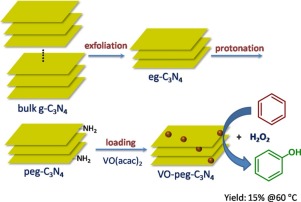Applied Catalysis A: General ( IF 4.7 ) Pub Date : 2017-09-14 , DOI: 10.1016/j.apcata.2017.09.015 Jie Xu , Ye Chen , Ying Hong , Huan Zheng , Dan Ma , Bing Xue , Yong-Xin Li

|
Direct hydroxylation of benzene is a sustainable and promising strategy to synthesize phenol. The key topic for the catalytic process is the development of an efficient heterogeneous catalyst. In this work, graphitic carbon nitride (g-C3N4) material was exfoliated and protonated, and then utilized as a support to load vanadia by using VO(acac)2 as a precursor. The synthesized materials were characterized by several techniques including N2 adsorption–desorption, XRD, TG, TEM, SEM, FT-IR, UV–vis, and XPS. The results exhibited that the exfoliation as a simple method could improve the surface area and pore volume of g-C3N4, while protonation was able to facilitate to increase the loading amount of vanadia. In hydroxylation of benzene to phenol in the presence of H2O2, the vanadia catalysts supported on peg-C3N4 demonstrated superior catalytic activity to the catalysts supported on the pristine g-C3N4. Moreover, the effects of protonation conditions including acid concentration and temperature on the final catalytic activity have also been investigated. Under optimized conditions, a maximum yield of phenol reached 15% at 60 °C.
中文翻译:

片状石墨氮化碳上负载钒的钒催化苯直接催化羟基化为苯酚
苯的直接羟基化是合成苯酚的可持续且有希望的策略。催化过程的关键主题是开发高效的多相催化剂。在这项工作中,将石墨氮化碳(gC 3 N 4)材料剥落并质子化,然后通过使用VO(acac)2作为前体将其用作负载钒的载体。合成材料通过多种技术进行了表征,包括N 2吸附-解吸,XRD,TG,TEM,SEM,FT-IR,UV-vis和XPS。结果表明,剥落作为一种简单的方法可以改善gC 3 N 4的表面积和孔体积,而质子化能够促进增加钒的负载量。在存在H 2 O 2的情况下苯的羟基化为苯酚中,peg-C 3 N 4上负载的钒催化剂表现出比原始gC 3 N 4上负载的催化剂更高的催化活性。此外,还研究了质子化条件(包括酸浓度和温度)对最终催化活性的影响。在优化条件下,苯酚的最大收率在60°C时达到15%。









































 京公网安备 11010802027423号
京公网安备 11010802027423号